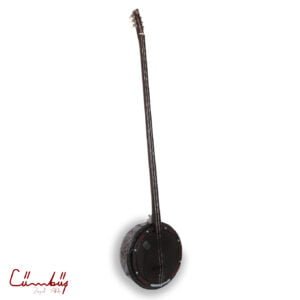- Call us
- Via Vicolo Galletti 2 , 48013 Brisighella (RA) / Italy
- WORLDWIDE FREE SHIPPING
Tanbur
Welcome to the Tanbur category at Tapadum Music Store, where you can explore the enchanting world of this remarkable instrument. The Tambur holds a significant place in traditional and classical music, captivating listeners with its mesmerizing melodies.
About Tanbur
Yayli Tanbur (Bowed):
The Yayli Tanbur, also known as the Bowed Tanbur, is a fascinating instrument played with a bow. It features a resonating body and a long neck, creating a unique sound that evokes deep emotions. With its bow, the Yayli Tanbur allows musicians to draw out expressive and haunting melodies, weaving intricate harmonies that resonate with the soul.
Mizrapli Tambur (Played with a Plectrum):
Tambur Played with a Plectrum is another captivating variation of this instrument. Played by plucking the strings with a plectrum, it produces vibrant and rhythmic tones. With its distinct technique, theTanbur lends itself to intricate melodies, allowing musicians to showcase their skills and create intricate musical patterns.
At Tapadum Music Store, we offer a wide selection of Tamburs, including both Yayli Tanburs and Mizrapli tanbur. Each instrument is crafted with precision and care, ensuring exceptional sound quality and playability. Whether you’re a seasoned professional or a passionate beginner, our Tamburs cater to musicians of all levels.
This traditional instrument a mesmerizing traditional Turkish instrument, carries with it centuries of musical heritage and cultural significance. With its hauntingly beautiful sound and intricate craftsmanship, the Tanbur stands as a testament to the rich musical traditions of Turkey.
Characterized by its long neck, pear-shaped body, and delicate strings, the tamboor is a lute-like instrument that exudes elegance and grace. Traditionally crafted from mulberry wood, the instrument’s resonant body and intricately carved details reflect the skill and artistry of its makers. The strings, usually made from silk or nylon, are stretched across the fretless neck and plucked with a delicate touch, producing a melodic richness that is both soul-stirring and evocative.
This musical instrument holds a central place in Turkish classical music, where it is revered for its ability to convey a wide range of emotions and moods. Its deep, resonant tones can evoke feelings of longing and nostalgia, while its lively melodies can inspire joy and celebration. In the hands of a skilled musician, the instrument becomes a vehicle for improvisation and self-expression, allowing for the exploration of intricate melodic patterns and subtle nuances.
Beyond its role in classical music, the Tanbur has also found a place in Turkish folk music, where it adds depth and texture to traditional melodies and rhythms. Whether played solo or as part of an ensemble, the Tamboor’s haunting sound transports listeners to distant lands and bygone eras, evoking the sights, sounds, and stories of Turkish culture.
Throughout history, the Tambur has remained a symbol of artistic expression and cultural identity in Turkey. From the royal courts of the Ottoman Empire to the bustling streets of modern-day Istanbul, it has endured as a beloved instrument, cherished by musicians and audiences alike.
Today, the this instrument continues to thrive, thanks to the efforts of dedicated musicians and craftsmen who are committed to preserving its legacy. Whether performing in concert halls, cafes, or festivals, the Tanbur remains a timeless symbol of Turkey’s rich musical heritage, captivating audiences with its enchanting melodies and timeless beauty.
This amazing instrument , an elongated-necked and fretted lute, has remained an essential component of Turkish musical heritage for ages. It stands as a favored instrument gracing both the platforms of classical orchestras and the communal gatherings of folk music enthusiasts. Its graceful structure and melodious resonance have enraptured audiences and musicians through successive generations.
Let’s explore its construction:
Fashioned from wood, the instrument body boasts a distinctive resemblance to a pear, functioning as a reverberating cavity for its dulcet and warm notes. Diverging from its western counterparts, the tanbur flaunts an elongated neck, typically embellished with frets crafted from gut or silk thread. Six strings, often arranged in three pairs (courses), are stretched tightly across the neck, lending their harmonies to the instrument’s melodic expression.
Distinctive sound and playing technique:
Unlike numerous fretted instruments, the tanbur eschews the practice of pressing strings against the frets. Instead, musicians employ a plectrum (known as mizrap), usually fashioned from tortoiseshell or similar materials, to pluck the strings. Intriguingly, only the lowermost course of strings sees direct manipulation, while the upper courses serve as resonating mediums, enriching the overall auditory experience.
The allure of this traditional instrument resides in its microtonal prowess. Turkish musical traditions embrace quarter tones, intervals finer than those prevalent in Western music. Through adept manipulation of strings and delicate finger placements, the tanburist (or tambur player) navigates these intricate sonic territories, fashioning a melody that captivates with its beauty and emotional depth.
The enduring legacy of the Tanbur in Turkish musical milieu:
The tanbur occupies a distinguished position within Turkish classical music, particularly within the Ottoman courtly customs. Its opulent timbre harmonizes seamlessly with other instruments such as the ney (flute) and ud (another form of lute), forming the bedrock of mesmerizing ensembles. Beyond classical realms, the tanbur thrives within Turkish folk traditions, augmenting folk melodies and dances with an aura of refinement and profundity, thus ensuring its cherished status in the hearts of the Turkish populace across the nation.
Free Shipping
To Europe & %0 Custom Tax
15 Days Warranty
15 days money back
Global Shipping
Worldwide Shipping
100% Secure
100% Secure Checkout



